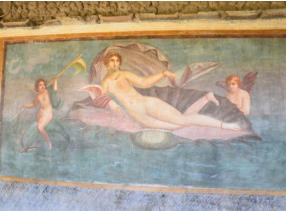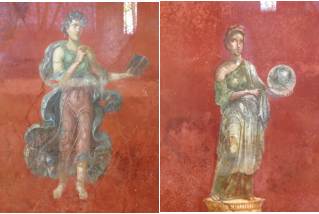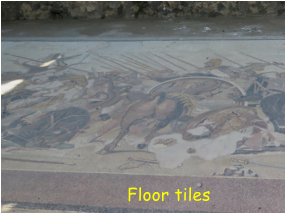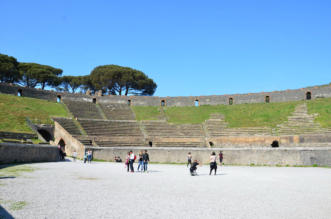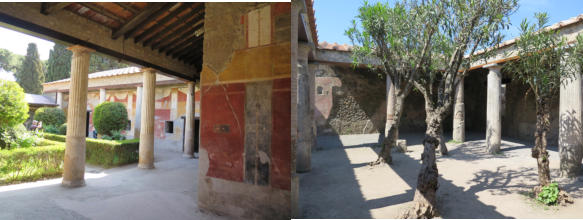

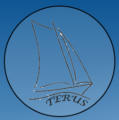









Our Journey: 2017
Pompeii: (15 April- 2017) & Herculaneum: (11 May 2017)

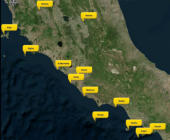
During our various trips in Italia we realized how much volcanic activities and earthquakes have  shaped the country and will continue to do so. We were reminded of the impact of the
shaped the country and will continue to do so. We were reminded of the impact of the earthquakes during our visits to Assisi and Sienna. At the end of 2016 Italy suffered a series of
earthquakes during our visits to Assisi and Sienna. At the end of 2016 Italy suffered a series of earthquakes around Rome. But one of the most tragic event in its history is undoubtedly the
earthquakes around Rome. But one of the most tragic event in its history is undoubtedly the story of Pompeii and Herculaneum, both cities located on the slopes of Vesuvius, south of Naples.
story of Pompeii and Herculaneum, both cities located on the slopes of Vesuvius, south of Naples.  Rich Romans had their luxurious villas in Pompeii because the climate was really pleasant, as they
Rich Romans had their luxurious villas in Pompeii because the climate was really pleasant, as they were located close to the sea and often enjoyed a fresh sea-breeze during the day. The ground
were located close to the sea and often enjoyed a fresh sea-breeze during the day. The ground was also fertile because of the volcanic activity and the soil give good grapes for good wine.
was also fertile because of the volcanic activity and the soil give good grapes for good wine.
 Unfortunately on the 24th of August 79 AD, Vesuvius erupted violently. There were some
Unfortunately on the 24th of August 79 AD, Vesuvius erupted violently. There were some warning signs, but not everybody considered them as serious. Ash was thrown 20km up into the
warning signs, but not everybody considered them as serious. Ash was thrown 20km up into the sky and suddenly, a hot flow of toxic gases at 500 degrees Celsius swept down the volcano and
sky and suddenly, a hot flow of toxic gases at 500 degrees Celsius swept down the volcano and instantly killed all those exposed to the gases. Afterwards, everything was covered in ash untill
instantly killed all those exposed to the gases. Afterwards, everything was covered in ash untill the 18 century when excavation started. Today some parts of Pompeii have been cleared and the
the 18 century when excavation started. Today some parts of Pompeii have been cleared and the ash removed so we can now see how the city was organized. At the beginning of the visit you can
ash removed so we can now see how the city was organized. At the beginning of the visit you can see docks for ships remindingus that Pompeii was located next to the sea.
see docks for ships remindingus that Pompeii was located next to the sea. 
 A little bit higher up, you reach the city of Pompeii with its numerous streets as well as public
A little bit higher up, you reach the city of Pompeii with its numerous streets as well as public gathering places such as the forum, the market and the amphitheater. Some streets were
gathering places such as the forum, the market and the amphitheater. Some streets were reserved for pedestrians with occasional big houses, but others were more commercial. The
reserved for pedestrians with occasional big houses, but others were more commercial. The commercial streets are seriously rutted in places due to the wheels of the ox-carts. Alongside
commercial streets are seriously rutted in places due to the wheels of the ox-carts. Alongside the commercial streets there were many small shops with restaurants that today could be
the commercial streets there were many small shops with restaurants that today could be compared to fast foods shops as people took the food away with them. More than 70 restaurants
compared to fast foods shops as people took the food away with them. More than 70 restaurants have been located so far. There were also numerous bakeries and around 40 brothels in Pompeii.
have been located so far. There were also numerous bakeries and around 40 brothels in Pompeii. At the intersection of the streets, there were some blocks of rocks that allowed pedestrians to
At the intersection of the streets, there were some blocks of rocks that allowed pedestrians to cross the streets without getting dirty. In those time the streets also served as the gutters.
cross the streets without getting dirty. In those time the streets also served as the gutters. 
 Some areas of the city were occupied by luxurious houses. Often the houses had 2 floors and a
Some areas of the city were occupied by luxurious houses. Often the houses had 2 floors and a central patio with a little pond. Pompeii had a water distribution system with lead pipes. The
central patio with a little pond. Pompeii had a water distribution system with lead pipes. The houses were very quiet places and the inside walls were beautifully decorated with paintings that
houses were very quiet places and the inside walls were beautifully decorated with paintings that have been well preserved because they were covered by ash. During our visit, a breeze nicely
have been well preserved because they were covered by ash. During our visit, a breeze nicely cooled the houses. Not far from Pompeii, we see Vesuvius reminding everybody that he is still
cooled the houses. Not far from Pompeii, we see Vesuvius reminding everybody that he is still there. Today geologists believe that while Vesuvius is for the moment dormant but he could
there. Today geologists believe that while Vesuvius is for the moment dormant but he could awake violently at any time. Let’s hope that the warning signs will be interpreted correctly next
awake violently at any time. Let’s hope that the warning signs will be interpreted correctly next time to avoid another tragedy.
time to avoid another tragedy.
 When you visit Pompeii today you do not get a morbid feeling. At one place you see somemolds
When you visit Pompeii today you do not get a morbid feeling. At one place you see somemolds  of bodies. Soon after being killed, the bodies were covered in ash forming a coffin. The corpses
of bodies. Soon after being killed, the bodies were covered in ash forming a coffin. The corpses started to decay and left a cavity in the ashes. Archeologists later filled the cavities with
started to decay and left a cavity in the ashes. Archeologists later filled the cavities with plaster and got molds of the victims. Some of the corpses are on display in Pompeii but most of
plaster and got molds of the victims. Some of the corpses are on display in Pompeii but most of them are preserved in Naples. If you want to complete your visit it is highly recommended that
them are preserved in Naples. If you want to complete your visit it is highly recommended that you visit the museum of Naples as it has a large collection of artifacts collected during the
you visit the museum of Naples as it has a large collection of artifacts collected during the excavations as well as numerous paintings that have been brought to the museum for better
excavations as well as numerous paintings that have been brought to the museum for better preservation.
preservation. Herculaneum
Often people associate Pompeii with Herculaneum. The 2 locations are separated from each
Herculaneum
Often people associate Pompeii with Herculaneum. The 2 locations are separated from each other by more than 15 km. Herculaneum being located more southerly than Vesuvius, has been
other by more than 15 km. Herculaneum being located more southerly than Vesuvius, has been less covered by ash. At the time of the eruption, Herculaneum was evacuated and the victims
less covered by ash. At the time of the eruption, Herculaneum was evacuated and the victims that have been found were close to the shore. Today archaeologists believe that they were
that have been found were close to the shore. Today archaeologists believe that they were waiting to be evacuated by sea, but unfortunately, rescue arrived too late. The bodies were not
waiting to be evacuated by sea, but unfortunately, rescue arrived too late. The bodies were not buried in ash so the skeletons of the unfortunate ones are all that remain there.
buried in ash so the skeletons of the unfortunate ones are all that remain there.
 The city is well preserved and when wandering in the streets you get a sense of what it was in
The city is well preserved and when wandering in the streets you get a sense of what it was in the old times. Herculaneum had several restaurants etc., but clearly it was quieter than Pompeii.
the old times. Herculaneum had several restaurants etc., but clearly it was quieter than Pompeii. Today a big part of the ancient city is still invisible as it lies underneath the modern city. If you
Today a big part of the ancient city is still invisible as it lies underneath the modern city. If you happen to be around Vesuvius take the timeto visit Herculaneum. Both cities are worth visiting
happen to be around Vesuvius take the timeto visit Herculaneum. Both cities are worth visiting because they give you a different perspective of what it was like in the time of the Romans..
because they give you a different perspective of what it was like in the time of the Romans..
 shaped the country and will continue to do so. We were reminded of the impact of the
shaped the country and will continue to do so. We were reminded of the impact of the earthquakes during our visits to Assisi and Sienna. At the end of 2016 Italy suffered a series of
earthquakes during our visits to Assisi and Sienna. At the end of 2016 Italy suffered a series of earthquakes around Rome. But one of the most tragic event in its history is undoubtedly the
earthquakes around Rome. But one of the most tragic event in its history is undoubtedly the story of Pompeii and Herculaneum, both cities located on the slopes of Vesuvius, south of Naples.
story of Pompeii and Herculaneum, both cities located on the slopes of Vesuvius, south of Naples.  Rich Romans had their luxurious villas in Pompeii because the climate was really pleasant, as they
Rich Romans had their luxurious villas in Pompeii because the climate was really pleasant, as they were located close to the sea and often enjoyed a fresh sea-breeze during the day. The ground
were located close to the sea and often enjoyed a fresh sea-breeze during the day. The ground was also fertile because of the volcanic activity and the soil give good grapes for good wine.
was also fertile because of the volcanic activity and the soil give good grapes for good wine.
 Unfortunately on the 24th of August 79 AD, Vesuvius erupted violently. There were some
Unfortunately on the 24th of August 79 AD, Vesuvius erupted violently. There were some warning signs, but not everybody considered them as serious. Ash was thrown 20km up into the
warning signs, but not everybody considered them as serious. Ash was thrown 20km up into the sky and suddenly, a hot flow of toxic gases at 500 degrees Celsius swept down the volcano and
sky and suddenly, a hot flow of toxic gases at 500 degrees Celsius swept down the volcano and instantly killed all those exposed to the gases. Afterwards, everything was covered in ash untill
instantly killed all those exposed to the gases. Afterwards, everything was covered in ash untill the 18 century when excavation started. Today some parts of Pompeii have been cleared and the
the 18 century when excavation started. Today some parts of Pompeii have been cleared and the ash removed so we can now see how the city was organized. At the beginning of the visit you can
ash removed so we can now see how the city was organized. At the beginning of the visit you can see docks for ships remindingus that Pompeii was located next to the sea.
see docks for ships remindingus that Pompeii was located next to the sea. 
 A little bit higher up, you reach the city of Pompeii with its numerous streets as well as public
A little bit higher up, you reach the city of Pompeii with its numerous streets as well as public gathering places such as the forum, the market and the amphitheater. Some streets were
gathering places such as the forum, the market and the amphitheater. Some streets were reserved for pedestrians with occasional big houses, but others were more commercial. The
reserved for pedestrians with occasional big houses, but others were more commercial. The commercial streets are seriously rutted in places due to the wheels of the ox-carts. Alongside
commercial streets are seriously rutted in places due to the wheels of the ox-carts. Alongside the commercial streets there were many small shops with restaurants that today could be
the commercial streets there were many small shops with restaurants that today could be compared to fast foods shops as people took the food away with them. More than 70 restaurants
compared to fast foods shops as people took the food away with them. More than 70 restaurants have been located so far. There were also numerous bakeries and around 40 brothels in Pompeii.
have been located so far. There were also numerous bakeries and around 40 brothels in Pompeii. At the intersection of the streets, there were some blocks of rocks that allowed pedestrians to
At the intersection of the streets, there were some blocks of rocks that allowed pedestrians to cross the streets without getting dirty. In those time the streets also served as the gutters.
cross the streets without getting dirty. In those time the streets also served as the gutters. 
 Some areas of the city were occupied by luxurious houses. Often the houses had 2 floors and a
Some areas of the city were occupied by luxurious houses. Often the houses had 2 floors and a central patio with a little pond. Pompeii had a water distribution system with lead pipes. The
central patio with a little pond. Pompeii had a water distribution system with lead pipes. The houses were very quiet places and the inside walls were beautifully decorated with paintings that
houses were very quiet places and the inside walls were beautifully decorated with paintings that have been well preserved because they were covered by ash. During our visit, a breeze nicely
have been well preserved because they were covered by ash. During our visit, a breeze nicely cooled the houses. Not far from Pompeii, we see Vesuvius reminding everybody that he is still
cooled the houses. Not far from Pompeii, we see Vesuvius reminding everybody that he is still there. Today geologists believe that while Vesuvius is for the moment dormant but he could
there. Today geologists believe that while Vesuvius is for the moment dormant but he could awake violently at any time. Let’s hope that the warning signs will be interpreted correctly next
awake violently at any time. Let’s hope that the warning signs will be interpreted correctly next time to avoid another tragedy.
time to avoid another tragedy.
 When you visit Pompeii today you do not get a morbid feeling. At one place you see somemolds
When you visit Pompeii today you do not get a morbid feeling. At one place you see somemolds  of bodies. Soon after being killed, the bodies were covered in ash forming a coffin. The corpses
of bodies. Soon after being killed, the bodies were covered in ash forming a coffin. The corpses started to decay and left a cavity in the ashes. Archeologists later filled the cavities with
started to decay and left a cavity in the ashes. Archeologists later filled the cavities with plaster and got molds of the victims. Some of the corpses are on display in Pompeii but most of
plaster and got molds of the victims. Some of the corpses are on display in Pompeii but most of them are preserved in Naples. If you want to complete your visit it is highly recommended that
them are preserved in Naples. If you want to complete your visit it is highly recommended that you visit the museum of Naples as it has a large collection of artifacts collected during the
you visit the museum of Naples as it has a large collection of artifacts collected during the excavations as well as numerous paintings that have been brought to the museum for better
excavations as well as numerous paintings that have been brought to the museum for better preservation.
preservation. Herculaneum
Often people associate Pompeii with Herculaneum. The 2 locations are separated from each
Herculaneum
Often people associate Pompeii with Herculaneum. The 2 locations are separated from each other by more than 15 km. Herculaneum being located more southerly than Vesuvius, has been
other by more than 15 km. Herculaneum being located more southerly than Vesuvius, has been less covered by ash. At the time of the eruption, Herculaneum was evacuated and the victims
less covered by ash. At the time of the eruption, Herculaneum was evacuated and the victims that have been found were close to the shore. Today archaeologists believe that they were
that have been found were close to the shore. Today archaeologists believe that they were waiting to be evacuated by sea, but unfortunately, rescue arrived too late. The bodies were not
waiting to be evacuated by sea, but unfortunately, rescue arrived too late. The bodies were not buried in ash so the skeletons of the unfortunate ones are all that remain there.
buried in ash so the skeletons of the unfortunate ones are all that remain there.
 The city is well preserved and when wandering in the streets you get a sense of what it was in
The city is well preserved and when wandering in the streets you get a sense of what it was in the old times. Herculaneum had several restaurants etc., but clearly it was quieter than Pompeii.
the old times. Herculaneum had several restaurants etc., but clearly it was quieter than Pompeii. Today a big part of the ancient city is still invisible as it lies underneath the modern city. If you
Today a big part of the ancient city is still invisible as it lies underneath the modern city. If you happen to be around Vesuvius take the timeto visit Herculaneum. Both cities are worth visiting
happen to be around Vesuvius take the timeto visit Herculaneum. Both cities are worth visiting because they give you a different perspective of what it was like in the time of the Romans..
because they give you a different perspective of what it was like in the time of the Romans..




